Virtual reality has different meanings for different people. Some pair it with gaming to create a more immersive experience. Others see VR as a business tool that can help them gain a competitive advantage. Yet others still are discovering that it can make their favorite activities more accessible. But you’ll soon discover the amazingly expansive world of VR for yourself.
Quick Menu:
- Virtual Reality, the Metaverse, and More
- What Is Extended Reality?
- What Is Virtual Reality?
- Types of Virtual Reality
- What Is the Difference Between Virtual Reality, Mixed Reality, and Augmented Reality?
- Components of Virtual Reality
- Virtual Reality Headsets – Fully Immersive World
- Virtual Reality Headset Accessories
- Virtual Reality Use Cases in Various Industries
- The Most Popular Virtual Reality Devices
Virtual Reality, the Metaverse, and More
If you’ve heard about virtual reality (VR) before then, there’s a good chance that it was in the context of the metaverse. The subjects are interlinked to the point where understanding one means needing to understand the other. So what is the metaverse?
Definitions can be complex since it’s a still in active development. But you can think of the metaverse as a bridge or merger between the online and physical worlds. It’s not a single program but a shared virtual universe that you can explore with others. It can be accessed in VR as an immersive 3D environment. But you can also use augmented reality and other interfaces to approach it differently. Even laptops or game consoles can access areas of the metaverse.
The sheer scope of the metaverse is truly immense. It’s essentially boundless, with no fundamental limitations on where you can go. You can even build within it and share those creations with others. And developers are expanding the metaverse infrastructure in exciting new ways. You can learn even more about this fantastic virtual reality destination in the article “Metaverse Guide; Understanding The Basics Will Open Up a New World”.
What Is Extended Reality?
The metaverse is largely tied to extended reality (XR) rather than just virtual reality technologies. XR is an umbrella term that refers to human-machine interface combined environments. It essentially describes anything that overlays one type of reality over another.
Extended reality can alter, or even replace, your standard sensory input like sight or touch. The usage scenarios for extended reality are truly breathtaking. It encompasses everything from gaming at home to assisting surgeons in hospitals. You can explore this expansive subject in the article “Extended Reality; What Is XR and How It’s Changing the Digital World”.
What Is Virtual Reality?
But what differentiates virtual reality from other forms of extended reality? One of VR’s most defining traits is immersion. Today’s VR headsets completely cover your eyes. The device’s detailed screens essentially substitute computer-generated environments with what you’d typically see when looking around. This ability to change what your eyes see allows for an unlimited number of usage scenarios. You can feed in views from distant locations through telecommunications.
Or you can take on the role of a character within a video game. You might even be able to learn how to perform complex tasks in the real world. Surgeons, in particular, have benefitted from the ability to practice their profession in a virtual environment. Even athletes are using VR to improve their performance. Interestingly, Sensorama systems arguably imply that VR has been in development since the 1950s. The machines integrated motion and smell into movies for improved immersion.
Video: Virtual Reality – SteamVR featuring the HTC Vive
Types of Virtual Reality
What’s it like to exist in the physical world? It’s a simple question, but it’s hard to reduce the entirety of the physical world to a single phrase or description. And the same is true of virtual reality. However, the following umbrella terms encompass the most popular types of VR.
Non-Immersive
Virtual reality is typically designed around immersion. But there are select cases where the opposite occurs. Non-immersive VR typically describes a system with digital environments displayed on a computer monitor rather than a headset. Users can naturally only interact with the digital environment through non-direct means. Websites that allow you to design a room’s decor are good examples of non-immersive systems. The same goes for video games with non-interactive environments.
Semi-Immersive
A semi-immersive VR environment is a midpoint between the other types. Semi-immersive virtual reality might be accessed through either monitors or VR headsets. Users will typically have some control over their environment within the simulation. However, the nature of those interactions is usually quite limited. Or in other words, the experience can be considered “on rails.” You can have a lot of freedom with a train’s controls in semi-immersive VR. But you wouldn’t be able to leave the train.
Fully-Immersive
This is what most people think of when virtual reality comes up. Fully-immersive VR incorporates multiple senses to immerse users in the experience of a new reality fully. This includes sight, sound, and possibly even tactile feedback. Appropriate gear is used to stimulate each sense. This includes headsets, gloves, and goggles. Fully-immersive systems might even let users feel the different ground beneath their feet through the use of special treadmills or stationary bikes.
What Is the Difference Between Virtual Reality, Mixed Reality, and Augmented Reality?
You might wonder what differentiates the various forms of extended reality. While XR tech tends to overlap, you can roughly define each type by certain traits. Virtual reality usually obscures the physical world. The only exception is non-immersive VR. But those usage scenarios are relatively rare within the larger context of VR.
Augmented reality enhances rather than replaces a user’s vision of the world around him. AR overlays digital data on top of the physical world, which is somewhat analogous to video games’ heads-up display (HUD). Mixed reality (MR) builds on this by merging digital and physical spaces through hologram-like projects.
You can delve further into the augmented reality side of things in the article “Augmented Reality; Learn About AR Tech, Use Cases, Devices, and More!”.
And if you want to learn more about mixed reality, then you’ll find a solid introduction in the article “Mixed Reality; Everything to Know About MR Technologies”.
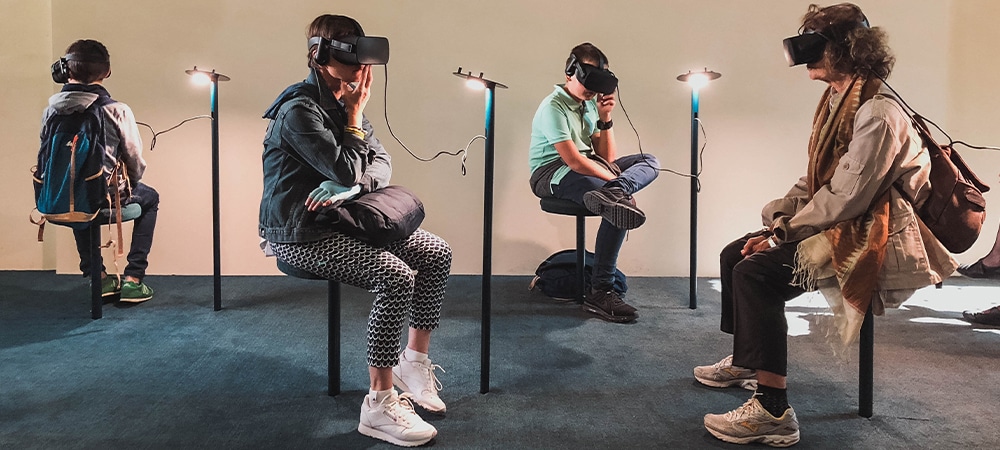
Components of Virtual Reality
At this point, it should be clear that a lot goes into a fully immersive experience with virtual reality. It takes some truly cutting-edge hardware and software to enter a new digital universe. While there are a lot of different VR components, these are the most important.
Virtual Reality Hardware Components
Virtual reality hardware components can be thought of as an accelerator of sorts. It’s what moves the various creations within VR beyond mere software or networking components and into a space that truly feels real. These are the main components that metaverse companies focus on to make it such a fantastic experience.
Input Devices
Input devices give you the ability to interact with the virtual world. It’s part of why the larger-scale metaverse meaning leans so heavily on interactivity. When you use input devices, you send signals to the system about your ultimate intent. The system will, in turn, simulate the result of any action just as if you were really there. Input tech comprises tracking, point input, biocontrollers, and voice devices. Tracking uses gyroscopic, ultrasonic, or other sensors to monitor user positioning. In contrast, point-input devices are closer to special mice or force balls. And voice control uses your voice for input.
VR Engine
A VR engine is one of virtual reality’s most complex software-based components. The underlying nature of VR is essentially numbers and code. The VR engine takes all of those numerical elements and translates it into something that looks shockingly similar to the physical world. VR engines need to recalculate a virtual environment about every 33 milliseconds while keeping framerates over 24 fps. Done right, the atmosphere feels so real that metaverse brands can often sell merch online that perfectly mirrors what’s found offline. But supporting that level of clarity is a difficult challenge for both hardware and software.
Output Devices
You might think that the VR engine is an output device. But the VR engine is software that needs to pass data to a screen or other hardware-based device. Different virtual reality output devices are tied to specific senses. For example, a VR headset stimulates the user’s sense of sight. Speakers work with audio (aural), and many controllers use haptic (force) for touch. And even smell and taste devices are in development. Vision is given top priority. And HMD and stereo display monitors are popular options. HMD provides two independent views that your brain interprets as a single 3D environment.
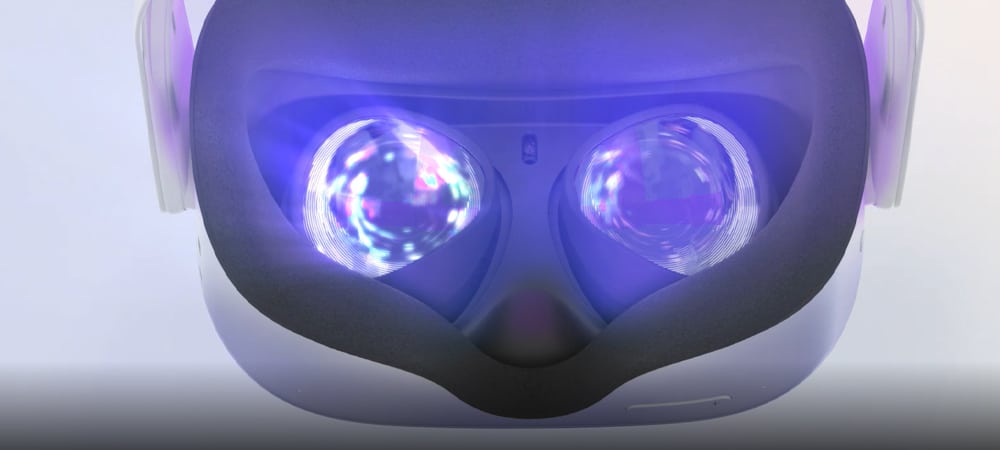
Image attribution: Oculus
Virtual Reality Software Tools
Virtual reality software tools are the systems used to create foundational elements of virtual environments. These are often distinct from the tools used by unaffiliated people accessing the VR system. You’ll often see the greatest level of user/developer crossover with modeling tools, which include software suites like 3ds Max, Blender, and Maya. The more engineering-focused work is often done in packages like CATIA, Solidworks, UG, and Pro/E. All of this is just one area of VR, the art and art-related development domains.
More software-focused development is typically done with various programming languages and APIs. This typically includes C/C++, Java/Java3D, OpenGL, and DirectX. However, the complexity of VR development means that additional wrappers and software development kits (SDKs) or application program interfaces (APIs) are used on top of those lower-level systems. In short, VR development uses more of a toolkit than a single tool.
Virtual Reality Headsets – Fully Immersive World
The term immersive comes up a lot when talking about virtual reality. Immersive environments are created from a wide variety of different sources. But VR headsets are arguably the most recognizable and important of these technologies. VR headsets consist of a stereoscopic, head-mounted display. Each eye is provided with a linked but still independent display. Headsets also use advanced multi-device motion tracking to move the display output to match a user’s gaze or head position.
There are some downsides to modern headsets. The most advanced headsets also come with an equally high price. And this is especially true of headsets that provide the most accurate tracking and display resolution. Many of the lower-priced models might have slight hiccups, like a small amount of latency if the user moves his head too fast. But for the most part, the modern VR headset can provide an amazingly immersive experience.
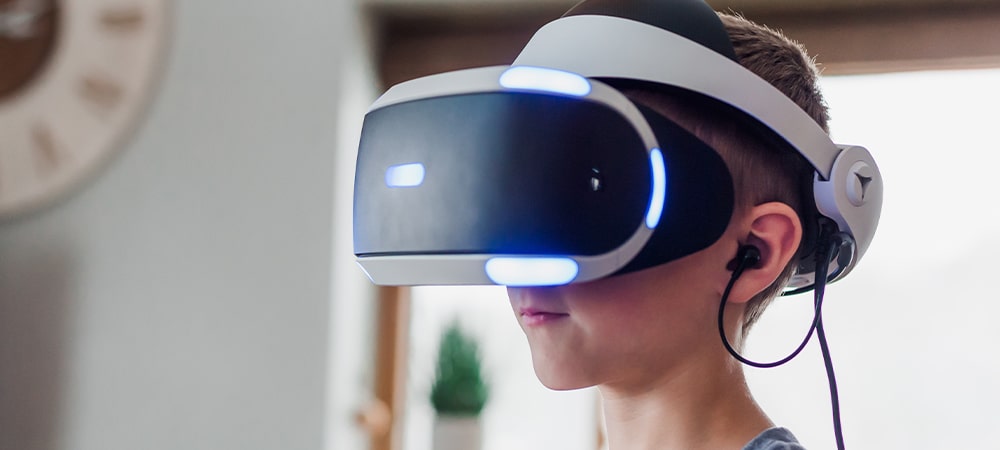
Virtual Reality Headset Accessories
Virtual reality headset accessories are a fantastic way to add new functionality to your VR setup. The gear typically either lets you make VR content or interact with it in new ways. Camera rigs are an example of the former, while trackers and hand controllers sit in the latter position. But all of these options are similar in that they give you a whole new level of freedom within the larger world of virtual reality.
VR Controllers & Backpacks
Controller upgrades can let you interact more naturally with the various objects you find in VR. For example, you might see a piece of NFT art that you like. And if a system supported it you could simply lift the NFT in your hand to examine it. And make no mistake, these controllers aren’t limited to the typical one size fits all solution typically shipped with headsets. There are special controllers for your hands, feet, and even fingers. The more your articulation is tracked, the more complex your virtual reality interactions can be.
Virtual reality backpacks also aid immersion by increasing your overall range of motion. They’re essentially portable power connectors for your gear. The additional power source can free you from the need to stay attached to an outlet or USB port. Backpacks can also extend the time you’ll be able to stay online within virtual reality.
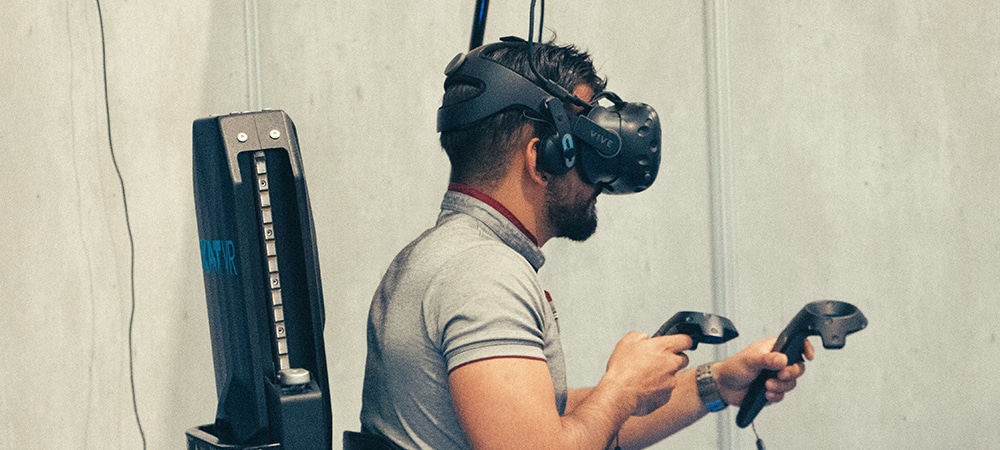
Virtual Reality Gloves, Masks & Shoes
Virtual reality gloves, masks, and shoes represent some more cutting-edge but still mainstream accessories. Gloves are a fairly straightforward addition to the VR experience. They have more advanced hand and even finger tracking than standard controllers. As such, you have far more control over your VR environment using a glove than you would with a standard controller.
Masks fit underneath the standard ocular headset. You might assume that a mask would focus on speech. But instead, masks focus on sensory input of areas all over your face. This can range from custom smells that are dispersed near your nose. Or you might feel tactile feedback from the mask on your cheeks. For example, you could feel virtual rain on your face while smelling the fresh scent of rain on a lush field. VR shoes can even make the experience of hiking in different terrains feel real!
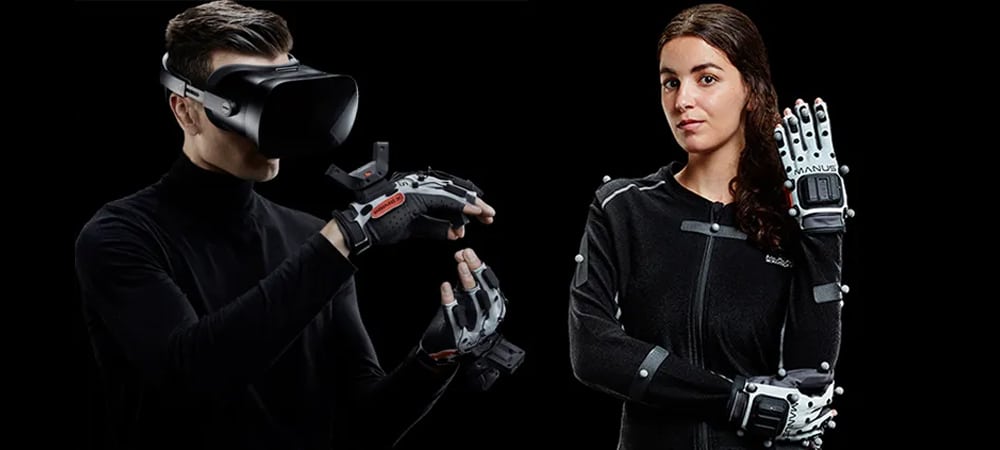
Image attribution: Manus
Virtual Reality Suits
The idea of positional tracking comes up a lot in any discussion of virtual reality. As tracking accuracy improves, so does a VR system’s ability to react to your movements. It shouldn’t be surprising to discover that you can use entire VR suits to track a vast array of your body’s positions. Feedback in the suit also lets you feel the results of those virtual interactions. You might feel the weight of a virtual object, heat, or cold in specific areas of your body. Or even the texture of an object you’re touching.
VR suits are a lot more cumbersome than standard motion tracking. And saying that they come with a high price is an understatement. But people who want the most immersive experience possible may want to check these special suits out because it is like moving your entire body into a virtual space.
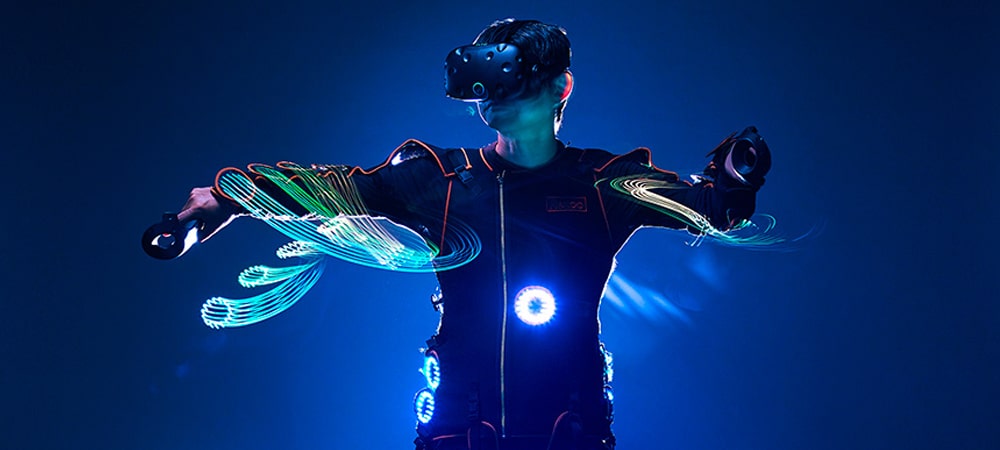
Image attribution: Synesthesia Suit
Virtual Reality Treadmills & Guns
Take a moment to think about how much of a workout you can get from treadmills at the gym. Now imagine how amazing it’d be to take that kind of workout along with you to any environment on earth, from trail running in national forests to jumping from boulder to bolder when hiking through the mountains. That’s the premise of VR treadmills. They let you really exert yourself in VR. But unlike traditional treadmills, they give you freedom of motion. You can move 360 degrees over various virtual reality environments.
You can add even more fun to this concept with a VR gun. Imagine jumping into your favorite first-person shooter with the ability to run and shoot enemies physically. However, there are more severe uses too. For example, VR guns and treadmills perfectly match military training. It’s all about surpassing physical limitations with technology.
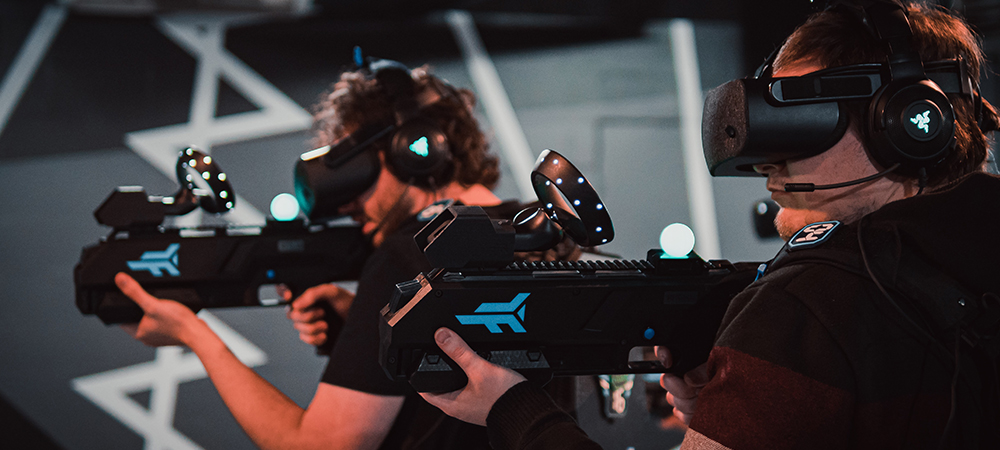
Virtual Reality Use Cases in Various Industries
It’s clear that VR can be used in many different ways. In fact, the versatility of options in virtual reality is a good match for the sheer variety of options you find in physical reality. This essentially means you can use VR for almost anything. And indeed, many different industries are leveraging VR for their own unique needs. The following illustrates some of the most innovative uses of VR within professional spheres.
Gaming
VR and gaming are a perfect match for each other. And virtual reality is considered one of the hottest gaming topics around for a good reason. The rising capabilities of VR quickly made gamers take notice. And now, most popular gaming platforms have one or more options for VR support. And some, such as Valve, have even produced their own VR headsets. There’s little doubt that VR has greatly impacted gaming as a whole. And it’s one of the industries where the progression of VR’s popularity is the most readily apparent. And that support just keeps on growing.
Video: 3 Ways VR Is Changing The Games Industry
Healthcare
Healthcare workers are using extended and virtual reality to hone skills and treatment options in a consequence-free environment. For example, surgeons can get an unlimited amount of practice in VR. But VR in healthcare isn’t just for doctors or nurses. Patients can get something out of VR too. Imagine benefiting from a professional’s guidance while working through home-based physical therapy. Or having a therapist guide you through VR sessions designed to fight your deepest phobias. VR has been beneficial to healthcare as a whole. But it’s essential for psychology, physiology, ENT, neurosurgery, and cardiology.
Video: Virtual Reality in the Healthcare Sector
Military
Like surgeons, military personnel often need to hone skills that will be used in life-or-death situations. And similarly, the military is using virtual reality to simulate those conditions in a safe environment. VR allows people to test combat tactics and deployment in almost any possible scenario. This can range from enemy territory to challenging environments like jungles or deserts. VR can also simulate complex military vehicles to let people learn how to get the most out of them. VR could simulate anything from submarine controls to a tank’s equipment.
Video: Virtual Reality Training For Police and Military
Education
Virtual reality is all about immersion. And teachers know that an immersive learning environment is vital to students’ success. VR can fully engage the left and right hemispheres when presenting information. This means that students can engage both their logical learning skills and their more emotional or creative takes at the same time. This type of education is more formally known as holistic learning. Educational institutions are also using VR to simulate hazardous situations, such as earthquakes or tornadoes, without their students ever being in any real danger. VR helps nurture students’ education and their overall safety too.
Video: Why the future classroom will have more VR applications than books
Retail
There are few industries as important to the economy as retail. It’s how products get to the public. And virtual reality is helping retailers design, implement, and even research their strategies to serve the public best. One of the essential additions offered by VR relates to overall aesthetics. VR can make shopping a lot more fun by creating an interactive and dynamic shopping cart experience. For example, IKEA stores have implemented a virtual reality kitchen system. People can jump into VR to check out a fully stocked kitchen before deciding if anything would match their own culinary needs.
Video: Explore a Retail Store in Virtual Reality
Marketing
Of course, marketing goes hand in hand with retail. And marketing has similarly benefitted from virtual reality. The fact that metaverse crypto is universal means that companies can market to people in every country. And brands can easily show just what their items are capable of. And this can take the form of full user engagement. For example, outdoor apparel brand Merrell created a VR experience where people could hike up a mountainside while wearing their hiking shoes. And the movie Intersteller had a tie-in VR experience where people could fly the iconic spaceship from the movie.
Video: Merrell’s “TrailScape” Virtual Reality eCommerce Experience
Sports
Millions of people regularly watch football, racing, tennis, and other sports. And a large number of them go to special events to participate as a fan. They also want to go but can’t due to various circumstances. But virtual reality now allows fans to jump into the action. You can watch matches through VR and it’s almost like being there, thanks to 360° cameras broadcasting the event. And the athletes benefit from VR as well. They’re able to train under a variety of different conditions. And they can even train remotely!
Video: VIVE TALK – How to Boost Athletic Performance with VR
Tourism
The idea of “try before you buy” is a valuable necessity in many areas. But until recently, it just hasn’t been possible for industries like tourism. Virtual reality has flipped that notion on its head. Many tourism sectors have begun integrating VR into their business strategy. For the first time, you can experience part of what it’s like to go to a remote destination vacation without ever leaving your home. For example, you could don a headset and fully explore beaches at various times of the year. Or even experience the wonder of gazing up as the clouds float by.
Video: Virtual Reality Travel
Architecture
Communication is one of the more difficult parts of architectural work. It’s not always easy to demonstrate to a client what the projected work will look like when completed. It’s easy for architects to transform ideas on a blueprint into perfect mental representations mentally, but not for clients. But virtual reality can bring clients in to look at the completed building within a virtual environment. At the same time, interiors are also highly compatible with VR. Remodeling is a snap when you can lay out new furniture and styles by moving them around in a digital space.
Video: Virtual Reality for Architects
The Most Popular Virtual Reality Devices
Now that you’ve seen what virtual reality can do, you’re probably ready to explore it for yourself. But this raises a vital question. What virtual reality device should you use? While there are many options on the market, the following selections are among the best.
Oculus Quest 2 (Meta Quest 2)
The Oculus Quest 2 (Meta Quest 2) is one of the most popular virtual reality headsets. One of its most essential features stems from how people use it. The leadup to the Quest 2 featured experiences with tethered PC connections and standalone apps. But the Quest 2 gives people the best of both worlds. It supports tethered PC games and native Oculus Quest apps that run without additional processing components. It even has wireless tethering on fast networks. The article “Oculus Quest 2; Overview, Features, Accessories and More!” will guide you through the device’s essential features.
Video: Introducing Oculus Quest 2
HTC Vive Pro 2
You might have heard about the HTC Vive Pro in the context of Valve’s Steam. It had early integration with SteamVR. This is still an essential element. But the Pro 2 has expanded on this idea through widespread integration with other, often unexpected, platforms. Integration comes through a special “VIVERSE” system. For example, the HTC Vive Pro 2 can access your smartphone, so you don’t need to take the unit off to check text messages or alerts. You can learn more about VIVERSE and Vive in the article “HTC Vive Pro 2; Learn About the Newest HTC VR Headset”.
Video: Meet VIVE Pro 2 | VIVE
Valve Index
Valve is essentially the defining name in the world of PC gaming. The company runs Steam, which is easily ranked as the most popular digital storefront and platform for PC games. However, a while back the company began to branch out into hardware. The Valve Index was one of the company’s biggest successes. As one would expect, this virtual reality headset offers the highest level of integration with SteamVR. And it’s a powerful platform unto itself. You can discover the full story and specs behind the Valve Index in the article “Valve Index; Learn About Valve’s Powerful VR Headset”.
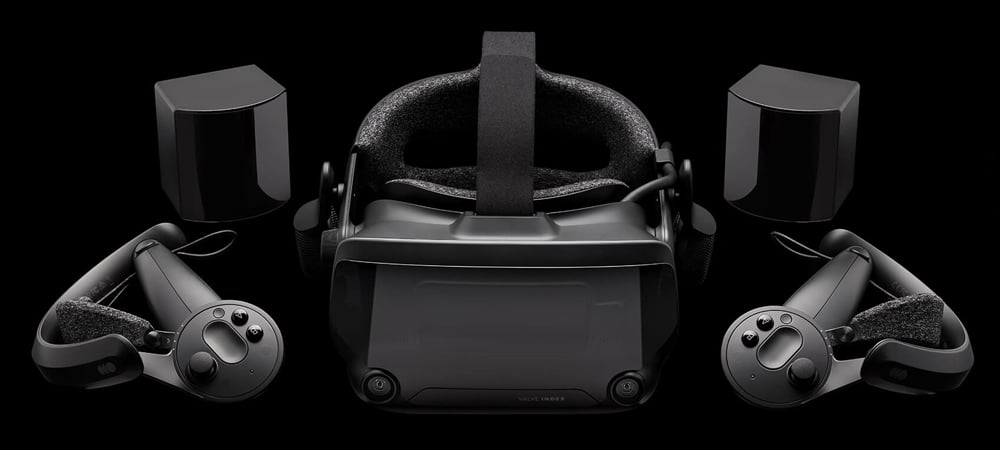
Image attribution: Valve Software
Sony PlayStation VR2
Sony’s one of the leaders in console gaming. And they’re also an enthusiastic supporter of console-based virtual reality. That devotion is readily evident in the Sony Playstation VR2. The company’s original system brought advanced hardware into the home at a reasonable price and equally surprising ease of use. But the VR2 is set to take those concepts further. The VR2 is slimmer and more powerful than the original model. It even pushes the resolution from the original 960×1080 to 2000×2040. You can see the evolution of Sony’s VR in the article “Sony PlayStation VR2; Learn About Overview, Features, and More!”.
Video: Feel a New Real | PS VR2
HP Reverb G2
The original Reverb was released in 2019. HP’s first entry into this line caught a lot of people’s eye. But the move to the HP Reverb G2 is even more impressive. The new virtual reality headset is so powerful that HP included two different usage modes. The first is full resolution, which lets users tap into the device’s full capabilities if their PC is powerful enough to support it. But the device also has a half-resolution mode for more modest gaming machines. HP has also partnered with Valve to use dual-element Fresnel lenses similar to what’s found in Valve’s Index.
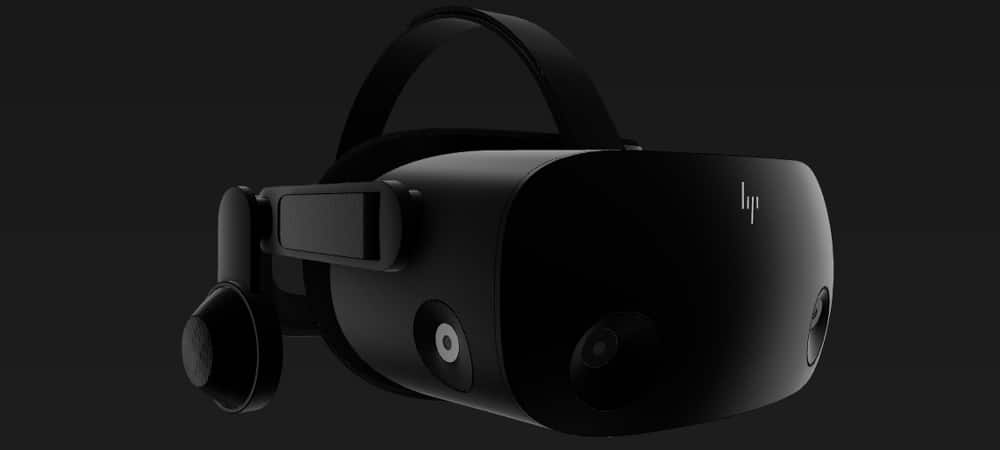
Image attribution: hp
Virtual reality has gone from science-fiction to science-fact in the blink of an eye. And you now possess all of the tools you need to master VR. You just need to decide which VR options appeal to you the most.
Did You Like This Article About Virtual Reality
You might also be interested in the following articles:
- Google Metaverse; Google’s Take on the Digital Universe
- Metaverse Standards Forum; What Is it & Why Is it Needed?
- Metaverse Startups; 10 Compelling Metaverse Startup Companies

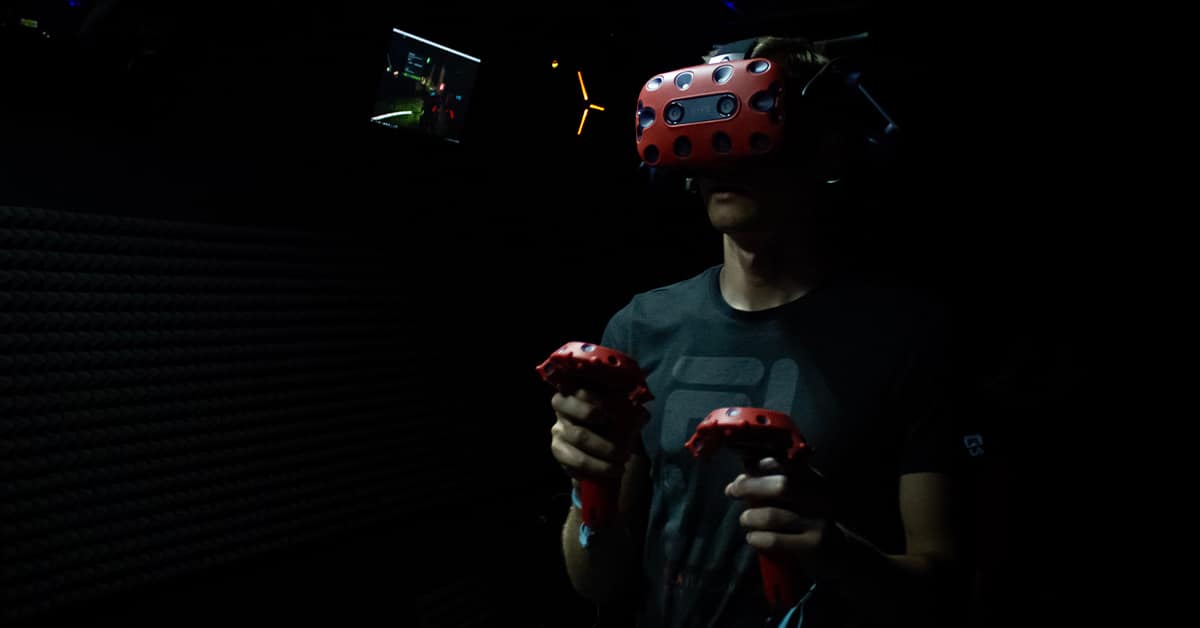
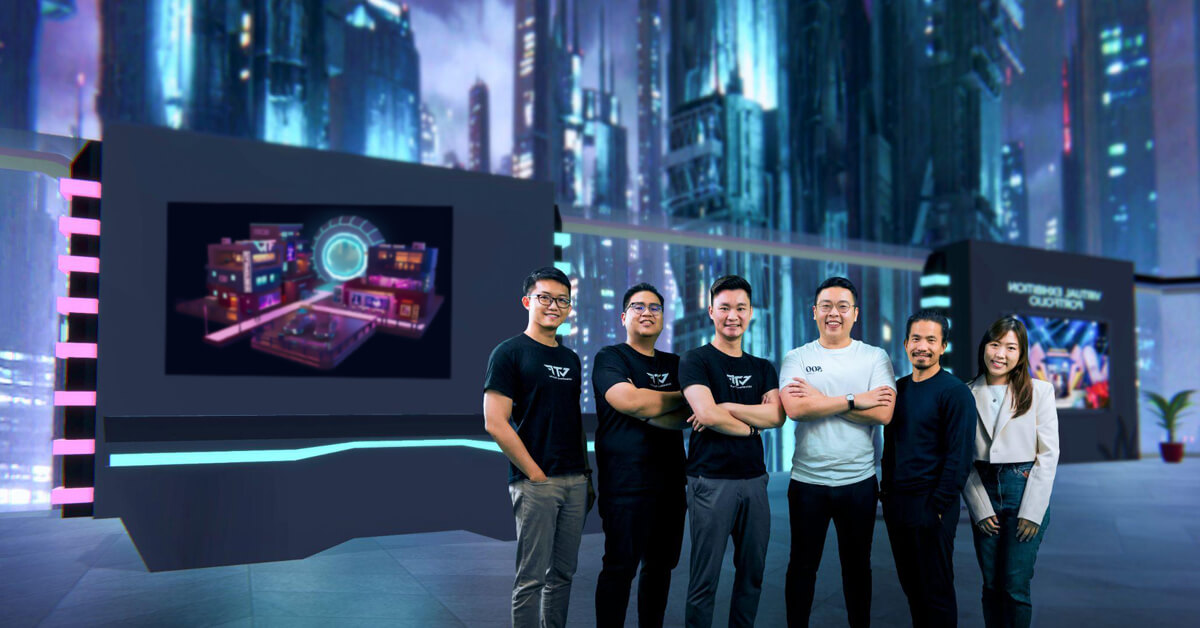

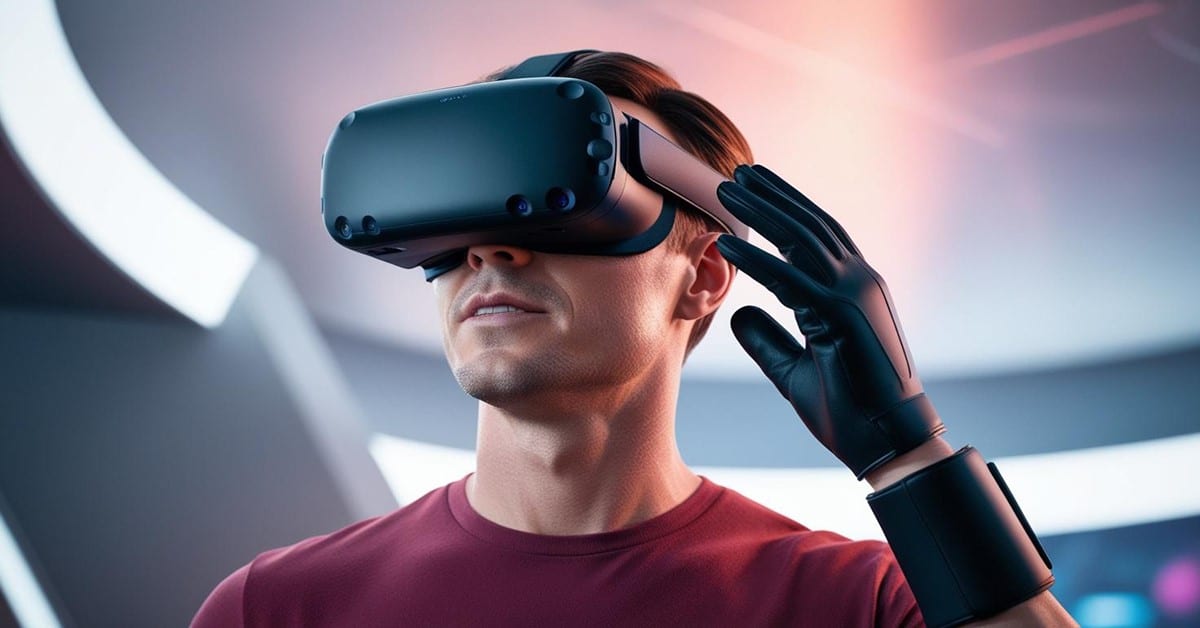

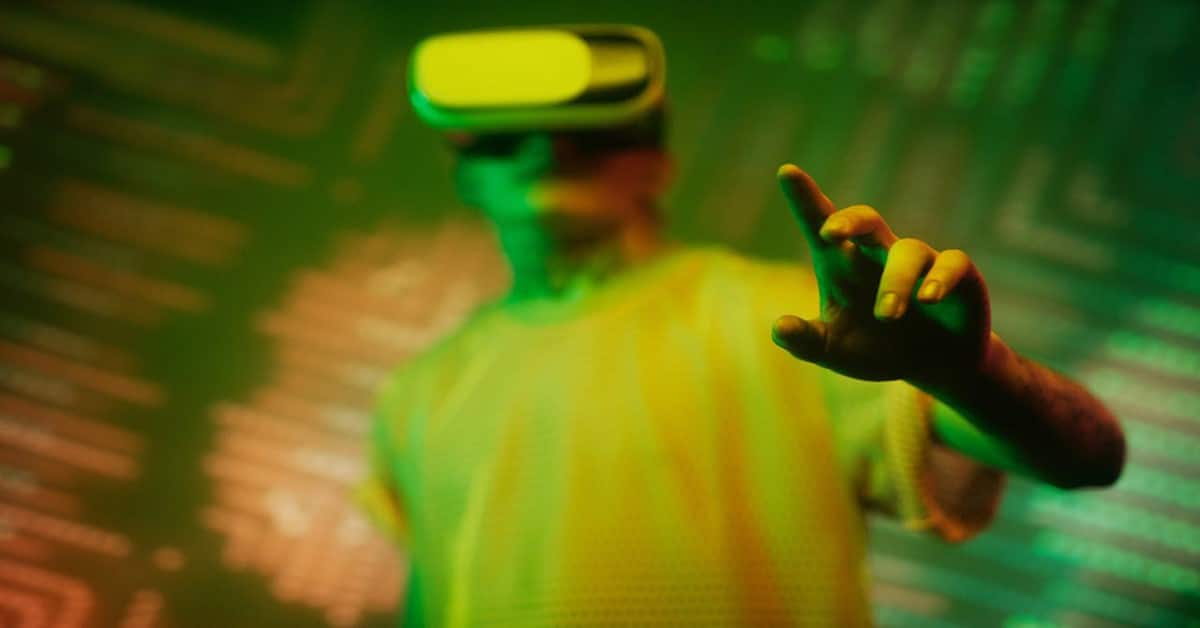


Leave A Comment